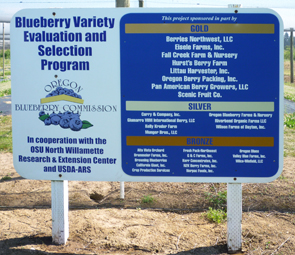|
Critical
Program Needs Industry Support
There’s no question that the Oregon Blueberry Evaluation and
Selection Program has proven invaluable to the Oregon blueberry
industry.
 Without it, growers wouldn't know which cultivars developed outside
the state are the best fit for Oregon and which ones won’t
work here.
Without it, growers wouldn't know which cultivars developed outside
the state are the best fit for Oregon and which ones won’t
work here.
The best example of this are the evaluations conducted by USDA-ARS
small fruit breeder Dr. Chad Finn, who identified Aurora, Draper
and Liberty, which were bred at Michigan State University, as the
best new advanced selections of the over 200 cultivars and advanced
selections tested by him at Oregon State University’s North
Willamette Research and Extension Center.
Subsequently, Aurora, Draper and Liberty have since risen to become
the top three blueberry varieties planted in Oregon the last three
years, according to blueberry nurseryman Dave Brazelton, owner of
Fall Creek Farm & Nursery.
While the Evaluation and Selection Program is funded in part by
USDA, OSU and the Oregon Blueberry Commission, it’s donations
from industry stakeholders themselves that “are key”
in maintaining the program, Finn said.
“What stakeholders kick in is significant. Percentage-wise
it’s not that big but it’s critical. Without that we’d
be in big trouble.”
Brazelton also said that the evaluation and selection program is
critical to the Oregon blueberry industry. “There’s
a lot of new (blueberry) material and we don’t know how it
performs in Oregon. We need to get good data for our growers. We
need consistent funding to make sure that the program continues.
Without the program, we may never have selected those particular
varieties … because they really didn’t do that well
in Michigan.”
He added that the program also helps growers by screening out those
cultivars that wouldn’t grow well in Oregon.
 |
| 2010
Sponsor Sign at NWREC |
Blueberry
growers, handlers, processors and suppliers are being asked to join
those who have already contributed in an effort to maintain this
program. To reach our goal for this year, we have three categories
for suggested contributions. They are: Bronze - $250 - $499; Silver
-$500 - $749; Gold - $750 or more.
Because your contribution is very important to this ongoing project,
we will see to it that contributors of $250 or more will be listed
on a sign at the OSU research and extension station near Aurora.
In addition to evaluating blueberry plants developed in other parts
of the country, Finn is also involved with breeding blueberry stock
more suitable to the Pacific Northwest.
“We’ve certainly had great success utilizing genetics
from other areas,” said Brazelton. “But there is also
interest in stepping that up to develop varieties that are selected
locally.”
Contributors should send their checks to the Oregon Blueberry Commission
office at P.O. Box 3366, Salem, OR 97302.
|
Articles:
Message from the Chairman
Spotted
Wing Drosophila Update
Market
Outlook:
A Look Back …
and Ahead
Bumbles
and Blueberries
Organic
Blueberry Production Research Project
Critical
Program Needs Industry Support
Small
Growers to Receive GAP Certification Aid
Oregon
Fresh Season Promotion On a Roll for 2011
Bee
Fees Jump a Bit
Smooth
Move Increases Insulin Sensitivity
New
Trap Hits
the Spots
(Spotted Wing Drosophila)
OSU
Researcher Driving Blueberries up a Tree
USHBC
Unveils New “Little Blue Dynamos” Positioning and Campaign
for Highbush Blueberries
Watching
World Acreage and
Production Grow
Specialty
Crop Grant Supports Oregon Berry Festival;
Free Berry Vendor Space Available
|

 Without it, growers wouldn't know which cultivars developed outside
the state are the best fit for Oregon and which ones won’t
work here.
Without it, growers wouldn't know which cultivars developed outside
the state are the best fit for Oregon and which ones won’t
work here.